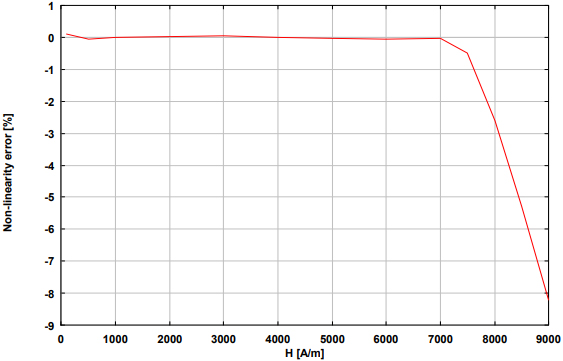HS 5136 Overview
The Hall sensor HS 5136 can be used to measure magnetic field strengths for immunity tests according to MIL STD 461 and various automotive standards. It measures static and dynamic magnetic fields with field strengths up to 9000 A/m (pk). The HS 5136 is a transverse probe, i.e. the magnetic flux lines must be orthogonal to the longitudinal probe axis and orthogonal to the surface of the Hall-element to obtain the maximum reading.
Power supply
The power supply is included in the scope of delivery of the HS 5136 (100 VAC - 240 VAC). A supply voltage of 12 VDC ±3 % is required at a current consumption of 250 mA.
Measurement of the output voltage
The output voltage can be measured using a high-impedance voltmeter at the BNC socket. The range of measurement is at least ± 9000 A/m (pk). (≅ ± 100 Gauss.) The output voltage is up to ± 8 V and proportional to the magnetic field strength. No damage can be caused by magnetic overloading of the Hall sensor.
1 mV equals the field strength of 1 A/m.
(1 G = 1Oe = 79,58 A/m = 100 µT = 0.1 mT; 1 A/m = 1,257 µT)
The linearity of the HS 5136 is very good. The deviation is typically below 0.1% at fields up to 7000 A/m (pk).. At 8000 A/m (pk). the linearity degrades by 2.6% because of compression. The sensor is useable up to 9000 A/m (pk).
| Non-linearity error by higher field strengths (measured at f=100 Hz). |
 |
Frequency response
Within the nominal frequency range (fig. 3) there is no need to apply any corrections to the measured values. The conversion factor in the nominal range is 1(A/m)/mV.
Measurement within a Helmholtz coil
The HS 5136 is a transverse probe. This means that the magnetic flux lines must be orthogonal to the probe axis and orthogonal on the sensor surface. The sensor tube has to be positioned in a way that the Hall probe is located perpendicular to the field lines and in the center of the Helmholtz coil. The Hall sensor itself is located approx. 6 mm away from the end of the tube and is parallel aligned to the labelled side of the housing.

Position of the Hall-Sensor
By varying the position and the rotation around the longitudinal axis of the housing the maximum of the magnetic field strength has to be determined.
Calibrating the sensor to zero
To be able to perform a zero point DC calibration an optional zero-Gauss chamber is available on request (Opt. 5136 ZG). The zero Gauss chamber eliminates the terrestrial static magnetic field as well as possible man made static fields. The zero Gauss-chamber is usually not required for the measurement of alternating magnetic fields.
If the sensor tube of the hall sensor is placed inside the zero-Gauss chamber, the zero point of the hall sensor can be measured with negligible Earth magnetic field influence. Sometimes multimeters allow to zero the reading to get rid of unwanted offsets and to measure relatively. The zero-point can also be adjusted with the offset-potentiometer. Alternatively the measured zero point voltage has to be subtracted from the measurement result.
Example of a measurement
The voltmeter shall be set to DC for the measurement of static magnetic fields and to AC for alternating fields. Assumption: Ucal to be the output voltage of the probe inside the zero Gauss chamber or with an inactive field generating device.
Measurement of the output voltage within the Gauss chamber: Ucal= -50 mV
Measurement of the magnetic field strength within a Helmholtz coil: U1 = 100 mV
Measurement within an identical magnetic field but the sensor turned around along the longitudinal axis 180°: U2 = -200 mV
[split]
| Specifications | |
| Nominal frequency range | DC...1 kHz |
| Nominal measuring range | 0 … 7000 A/m (peak) |
| Extended measuring range | 0 … 9000 A/m (peak) |
| Nominal conversion factor | 1 (A/m) / mV |
| Load impedance | >2 kΩ |
| Non-linearity error | 0.8 % |
| Power supply | 12 VDC ±3 % / 250 mA |
| Operating temperature ambient | 15°C – 30°C |
| Housing | Aluminium |
| Dimensions | ca. 470 x 42 x 28 mm |
| Mounting | D = 22 mm, L = 120 mm |
| Weight | 300 g |
| Connector | BNC female |









